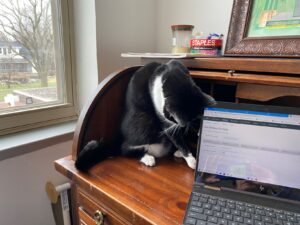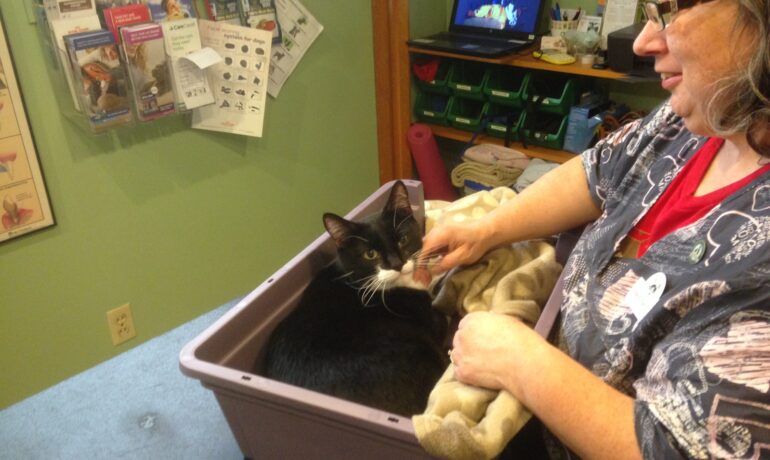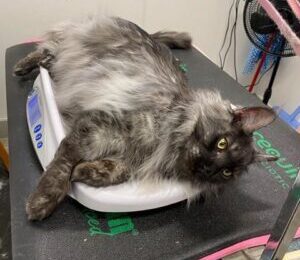5 steps to take the stress out of medicating your cat
One of the most common dilemmas cat guardians have is administering medication at home. Pills, eye, or ear drops often result in scratches, struggles, and bites. As a veterinarian, I never thought about the difficulty a client might have, as it was not difficult for me. As I learned more about behavior, became a bit more experienced as a practitioner, and just a better listener I realized I needed to ask my clients about the stress of home care before I prescribed anything. I asked my clients to “Tell me exactly what it is like for you and your cat to give a pill/eye/ear or liquid medication?” Wow! I heard many stories of struggling cats, bites, and scratches from the client. The client felt that there were no other options to give medications. The amount of feline anxiety created by home care concerned me, and I knew I had to be proactive in providing not only the medication but the plan to make home care less stressful for all.
Where do you start?
Adapting the Low-Stress care techniques for home use was step one. Changing the form of the medication from a pill to a liquid or transdermal gel was step two. Lastly, an open-minded approach to how the medication would be administered was step three. Integrating my knowledge of the pharmacokinetics of the medications, the way to train the cat to accept the home care, plan, and partnering with the client to teach them the steps of Low-Stress handling, was the key to successful home care. My technicians were instrumental in helping clients learn how to use towels and treats and understand their cat’s needs for comfort.
I think having a good relationship with a compounding pharmacy is essential for creating a Low-Stress home medication plan. The pharmacists at the apothecaries have a wealth of knowledge about what medications are effective and stable as transdermal gels, tiny taste tabs, or liquid. The staff often spends time with the client to know what flavors the pet likes, and what type of syringe or pen style is easier for the client to use. Each of these aspects is helpful in creating a Low-Stress plan.
An injectable form of the medication may be easier to give than oral. If a cat is very sensitive to any touch to the face, think of what injectable form of medication can be used. With a small dish of tuna, many cats will tolerate an injection with little to no handling.
The 5 step plan
Here are the steps to create a Low-Stress Home Care Plan for your cat.
- Ask the client how they give medication, and what the cat acts like before, during, and after. The touch, reach, or item that causes the cat to hide, or struggle is the trigger for stress. Avoiding these triggers, and changing the approach is the quickest way to decrease stress. Download the Feline Ladder of Aggression here and match what the cat looks like with each step of the process of medicating the cat. This will help you find the triggers to eliminate.
- Now that you know the stress triggers, think creatively about what can be eliminated or changed. If the cat is struggling with a pill, consider a liquid, tiny taste tab, transdermal or injectable. Listen to your client describe the process – if the cat hisses, swats, or attempts to bite stop! Do the opposite of what the past process was to decrease the aggression. If the cat was held – use food for the cat to eat, and no one holds the cat. If the client chases the cat down, teach the cat to come to the medication area by giving treats every day for coming to the area without medicating. Offer a tech appointment with the client present to learn from the tech how to give the medications.
- Show the client how to set up a home care area. A counter or tabletop with a nice blanket, and super delicious treats are the basics to have. Now, call the cat up to this area for treats and nothing else. You want your cat to experience this medication spot as a fun place to be at any time. Use Feliway spray to mark the area as well.

Binx loves the desk – a good place to start for a medication spot.
- Every step of the process of giving the medication needs to be matched with whatever is rewarding to the cat – tidbits of treat, rubbing the cheeks, a soothing voice. This helps the cat to learn each step has a reward for them. If the cat will not eat or starts to increase in body tension – stop. Do not go further. Check to see what you can eliminate (get your hands off their body) or can keep that stimulus to no longer than one second. If you keep touching the cat, you may over-stimulate the cat, and cause stress escalation. Keeping holds and touch short, limits escalation. I think this concept can be the toughest part to change for both cat parents and veterinary staff. We think logically – that holding longer will prevent the cat from struggling but, they struggle more. Be aware of keeping any restraint to a minimum and relax your hold quickly.
- Give the cat some time and rewards when you have finished relaxing on the medication spot. This is the concept of the “Last Memory is the lasting memory.” If you allow the cat to jump down or run away, they are doing so in fear. If you give the cat a few seconds to calm down and they take a reward, it builds the good memory that this spot is nice to be on. And that is the point of Low-Stress care – to have the pet choose to cooperate for care.

This cat loves the scale – he had treats and was allowed to relax here.
Take the time to listen to your client’s difficulties. Look at the situation from the cat’s and the owner’s point of view. Be open to alternative routes of medication – liquid, transdermal, or injectable. Lastly, check in with your clients and cat parents and report back to your vet how the new plan works out.
To learn more about how to create a Low-Stress Home care plan, visit my shop and take the “Spicy Cat Low- Stress home Care workshop.” This is a recording of my two-hour workshop with the presentation, and live cat demonstration of various ways to administer oral, eye, ear, and injectable medication. I also discuss ways to help your cat travel to the veterinarian and the medications and supplements that help decrease feline anxiety during care. This is a great course for veterinary, shelter, rescue staff, and of course cat guardians! Handouts and bonus videos are included Click here to purchase
Thank you for supporting Low-Stress care for our animals. I love to hear your stories of success – please email me or comment below!
Sally J Foote DVM, CABC-IAABC, LSHC-S, FFE

